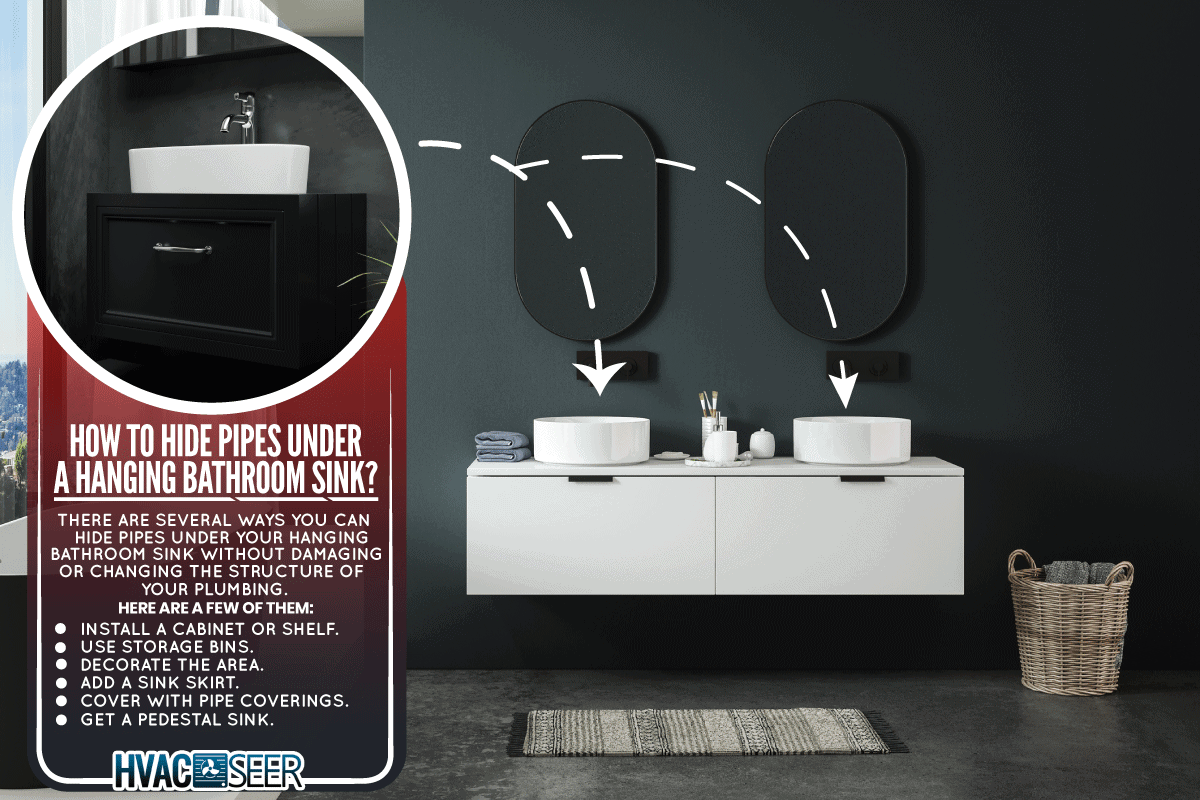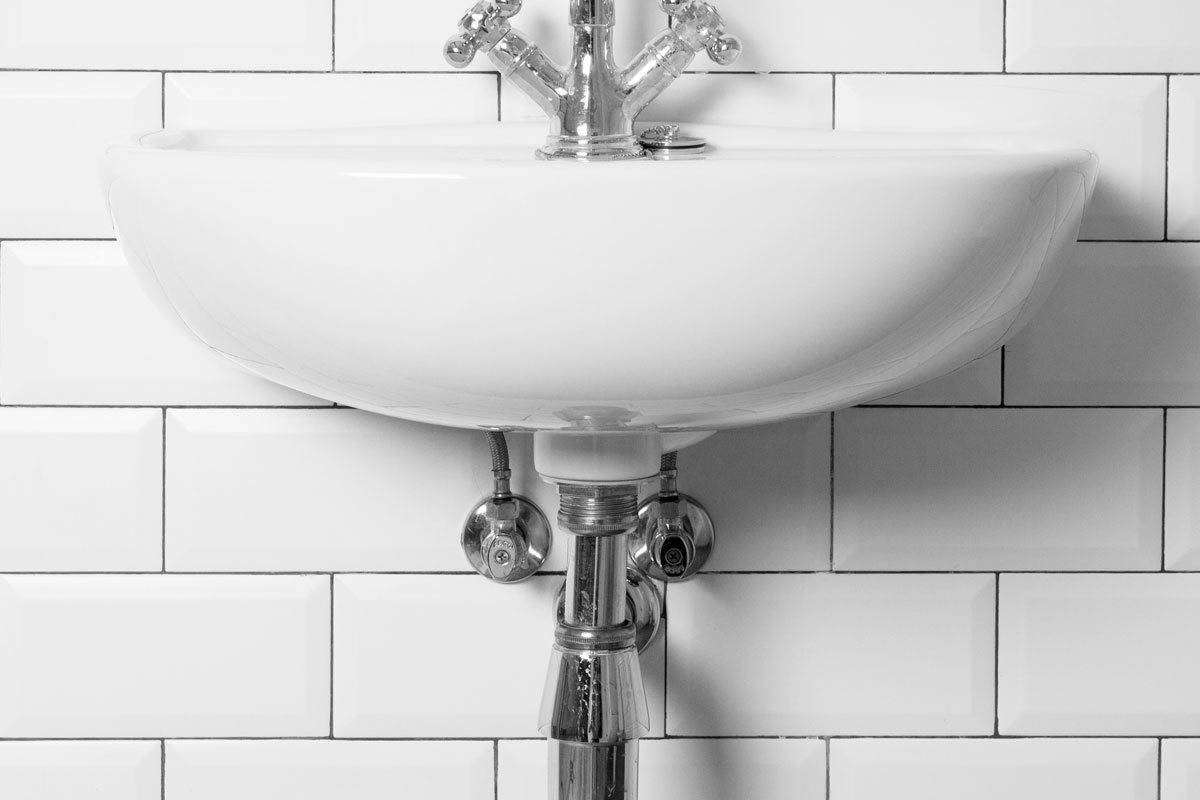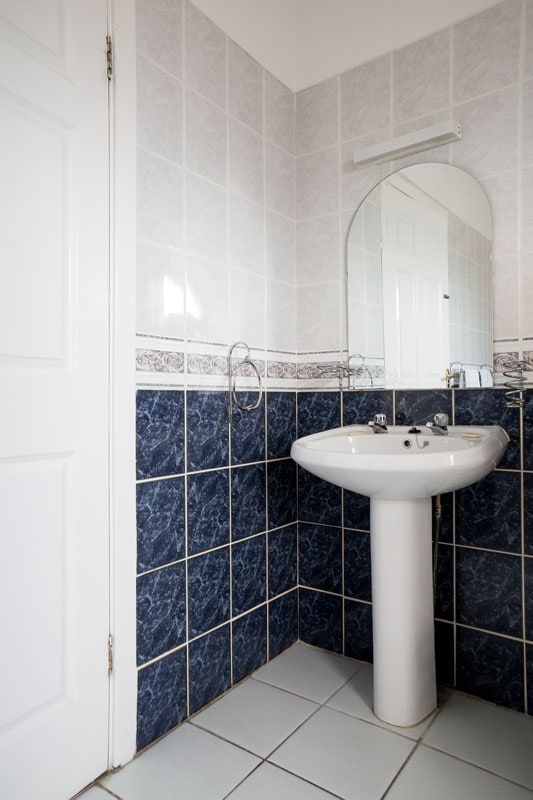While plumbing is essential to your home, it could be an eyesore when left out in the open, especially in smaller areas like the bathroom. If you feel bothered by the idea of visible pipes in rooms, you might be considering how to hide them. To guide you, we researched to give you the options and explained each method.
There are several ways you can hide pipes under your hanging bathroom sink without damaging or changing the structure of your plumbing. Here are a few of them:
- Install a cabinet or shelf.
- Use storage bins.
- Decorate the area.
- Add a sink skirt.
- Cover with pipe coverings.
- Get a pedestal sink.
Generally, it only takes a few steps to get each method done. If you need to adjust the plumbing to get the work done, consider contacting an HVAC professional for assistance.
Covering pipes under your bathroom sink is not a primary requirement, but it helps keep your bathroom looking tidy and pleasant. Keep reading to learn more about bathroom pipes and how to cover them up.

Can You Hide Exposed Pipes Under A Hanging Bathroom Sink?
Compared to other sink options, a wall-mounted or hanging sink saves you lots of space in the bathroom. But the major downside is having to deal with the exposed plumbing.
Fortunately, you can keep those pipes hidden under a hanging bathroom sink. You can do this in different methods, but whichever you choose is primarily up to you and your preferences or needs.
If you can't find a covering method that satisfies you, consider replacing your sink with a pedestal sink or other types that provide a full cover.

How To Hide Visible Pipes In The Bathroom
Here are a couple of ways to hide bathroom pipes.
Install A Cabinet Or Shelf

One of the best ways to maximize space efficiency while covering unsightly exposed plumbing is by installing a cabinet or shelf under the sink. The process is inexpensive but may require you to have at least basic handyman skills.
Follow these steps to learn how to install an under-sink cabinet on your own:
1. Plan It Out
Kickstart your DIY project with a plan by looking through the space available under your sink, then figuring out how you want to add the cabinet or shelf from there. You can consult a professional for advice to avoid too many changes later on.
A part of the planning includes identifying the items you want to store under your sink. Will it be bath essentials or toiletries? Towels or tissue rolls? When deciding what to place in your new cabinet or shelf, evaluate your current storage space and determine which items you use regularly and occasionally. You can also consider how much space each item takes up, then see which of them fits best without wasting extra room.
2. Decide The Placement
Before installing the cabinet, you should decide where to position it. You can keep the sink on top of the cabinet or under-mounted.
The cabinet's placement is essential in ensuring the plumbing stays covered. At the same time, it allows you to have enough room for additional storage without disrupting the plumbing.
3. Take Measurements
After you map it out, take measurements to get an accurate look at the space you'll have available once you install the cabinet. It gives you time to make last-minute plan changes, such as which items to store in it. When you're ready to finalize everything, you can mark positions and note the rest of the measurements required to purchase the materials, including the height, length, surrounding area, and other necessary points.
Note that it's essential to ensure you get a precise measurement of the area surrounding the bathroom sink, considering how you want to position the cabinet or shelf. That way, you can have the parts showing the pipes covered completely.
4. Fit The Pieces
Purchase your pieces and see how it fits on your sink. If you're working with parts from scratch, prepare them and dry-fit them each time. While fitting the pieces, leave enough space around the pipes. Cut the holes as small as possible without putting too much pressure on the plumbing.
5. Install, Secure, Paint
Install each piece when you're ready, then secure them as much as needed. Confirm if all the pieces are stable and secure, then paint or stain them to finish them off.
You can also purchase a ready-made sink cabinet and hire a contractor to install it. The price starts as low as $100 and higher, depending on the size, type, and installation.
Use Storage Bins
Storage bins are another way to hide exposed sink pipes without requiring installation. Like cabinets, these also double as storage while keeping plumbing covered.
You can look around for bins or baskets big and tall enough to cover the length of the plumbing. If you're looking to purchase them, measure the area you want to hide to ensure the bins fit and offer enough coverage.
Click here to see these storage baskets on Amazon.
Decorate The Area
If you want to hide pipes and add to your bathroom's visual, decorating under the sink and in front of the plumbing is a great way to do both! It allows you to liven up your space while maintaining space efficiency.
Here are a few types of décor you can try out.
Plants

Potted plants are a quick and easy way to add life to a room. They come in various styles and sizes, allowing you to choose the best fit for your home's interior with the right amount of cover. Note that having plants requires maintenance and specific temperature, so pick plants that fit your bathroom's conditions best.
Faux Cabinets Or Cover
A faux cabinet or sink cover works if you want to cover the pipes from top to bottom completely. You can style it any way you want to suit your bathroom's existing interior. However, a faux cabinet or cover may not be the right option if you want to use the space better.
Sink Skirt
You could think of a sink skirt as a lighter version of the sink cover since it functions similarly but uses a curtain-like material. It takes up less room and has less volume, making it suitable for homeowners who want to save space.
Below are steps on how to install the skirt.
- Measure the size around and beneath your sink. These include the circumference of your sink's bowl and the distance between the lower rim and the floor. These will be the measurements of your fabric.
- If you're making the cover from scratch, cut the fabric to your measurements, leaving an inch on each side to make room for the hem.
- To hem the cover, fold the extra inch in half and sew along the way.
- With your previous measurements, cut a length of Velcro or adhesive and stick it onto the lower rim. Make sure it sticks on firmly. If you're using Velcro, sew the other side to your fabric.
- Attach the skirt to the sink. Note that some store-bought sink skirts may come with separate instructions according to the manufacturer.
Click here to see this bathroom sink skirt on Amazon.
Pipe Coverings
If you don't like the look of the metal or PVC pipes, you can conceal it with pipe coverings or tubes. These come in varied sizes, colors, and materials and are easy to find in local hardware stores. You can also make your own through sewing, crochet, or other craft forms.
Click here to see these pipe insulation noodles on Amazon.
Get A Pedestal Sink

You can replace your hanging bathroom sink with a pedestal sink if you want to have your pipe cover built-in. A pedestal sink can stand alone and hides plumbing within it. It costs approximately $330 to $730 to install, excluding the cost of the sink itself. Location or additional work also adds up to the final price.
If you want to install a pedestal to your wall-mounted sink, you might have to contact a professional to evaluate your existing setup.
Is It OK To Leave Bathroom Pipes Exposed?
Generally, there's no issue with leaving the pipes in your bathroom exposed. However, it comes with a few drawbacks. You will likely have exposed plumbing work when installing a wall-mounted or hanging sink. Although it's common, it can lead to a few dangers and risks that affect your sink's functionality.
Because of bumping or scraping, exposed pipes are prone to damage, which can potentially cause leaks if the impact is strong enough. Depending on the material, they can be challenging to clean, especially when they start accumulating rust or debris.
To Summarize

There are many ways to hide visible plumbing, each providing different functions and styles. You can turn it into an extra storage area by installing cabinets or bins or transform it into a decorative space by adding plants and styled covers. If you prefer a stand-alone sink with a built-in cover, you can replace it with a pedestal sink.
Read these posts to learn more about bathroom improvement:



